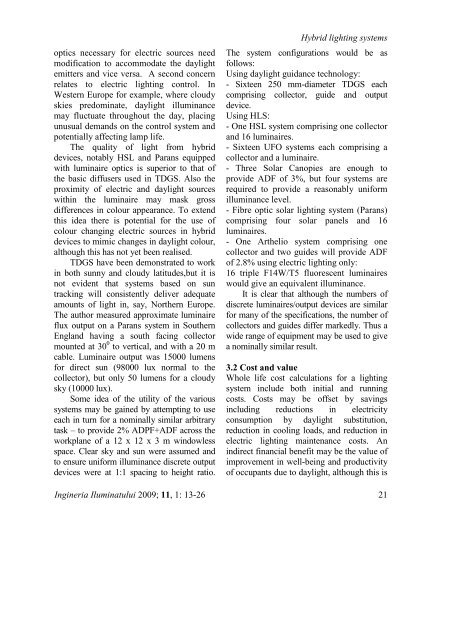ingineria iluminatului - Journal of Lighting Engineering - Prof. Florin ...
ingineria iluminatului - Journal of Lighting Engineering - Prof. Florin ...
ingineria iluminatului - Journal of Lighting Engineering - Prof. Florin ...
You also want an ePaper? Increase the reach of your titles
YUMPU automatically turns print PDFs into web optimized ePapers that Google loves.
optics necessary for electric sources need<br />
modification to accommodate the daylight<br />
emitters and vice versa. A second concern<br />
relates to electric lighting control. In<br />
Western Europe for example, where cloudy<br />
skies predominate, daylight illuminance<br />
may fluctuate throughout the day, placing<br />
unusual demands on the control system and<br />
potentially affecting lamp life.<br />
The quality <strong>of</strong> light from hybrid<br />
devices, notably HSL and Parans equipped<br />
with luminaire optics is superior to that <strong>of</strong><br />
the basic diffusers used in TDGS. Also the<br />
proximity <strong>of</strong> electric and daylight sources<br />
within the luminaire may mask gross<br />
differences in colour appearance. To extend<br />
this idea there is potential for the use <strong>of</strong><br />
colour changing electric sources in hybrid<br />
devices to mimic changes in daylight colour,<br />
although this has not yet been realised.<br />
TDGS have been demonstrated to work<br />
in both sunny and cloudy latitudes,but it is<br />
not evident that systems based on sun<br />
tracking will consistently deliver adequate<br />
amounts <strong>of</strong> light in, say, Northern Europe.<br />
The author measured approximate luminaire<br />
flux output on a Parans system in Southern<br />
England having a south facing collector<br />
mounted at 30 0 to vertical, and with a 20 m<br />
cable. Luminaire output was 15000 lumens<br />
for direct sun (98000 lux normal to the<br />
collector), but only 50 lumens for a cloudy<br />
sky (10000 lux).<br />
Some idea <strong>of</strong> the utility <strong>of</strong> the various<br />
systems may be gained by attempting to use<br />
each in turn for a nominally similar arbitrary<br />
task – to provide 2% ADPF+ADF across the<br />
workplane <strong>of</strong> a 12 x 12 x 3 m windowless<br />
space. Clear sky and sun were assumed and<br />
to ensure uniform illuminance discrete output<br />
devices were at 1:1 spacing to height ratio.<br />
Hybrid lighting systems<br />
The system configurations would be as<br />
follows:<br />
Using daylight guidance technology:<br />
- Sixteen 250 mm-diameter TDGS each<br />
comprising collector, guide and output<br />
device.<br />
Using HLS:<br />
- One HSL system comprising one collector<br />
and 16 luminaires.<br />
- Sixteen UFO systems each comprising a<br />
collector and a luminaire.<br />
- Three Solar Canopies are enough to<br />
provide ADF <strong>of</strong> 3%, but four systems are<br />
required to provide a reasonably uniform<br />
illuminance level.<br />
- Fibre optic solar lighting system (Parans)<br />
comprising four solar panels and 16<br />
luminaires.<br />
- One Arthelio system comprising one<br />
collector and two guides will provide ADF<br />
<strong>of</strong> 2.8% using electric lighting only:<br />
16 triple F14W/T5 fluorescent luminaires<br />
would give an equivalent illuminance.<br />
It is clear that although the numbers <strong>of</strong><br />
discrete luminaires/output devices are similar<br />
for many <strong>of</strong> the specifications, the number <strong>of</strong><br />
collectors and guides differ markedly. Thus a<br />
wide range <strong>of</strong> equipment may be used to give<br />
a nominally similar result.<br />
3.2 Cost and value<br />
Whole life cost calculations for a lighting<br />
system include both initial and running<br />
costs. Costs may be <strong>of</strong>fset by savings<br />
including reductions in electricity<br />
consumption by daylight substitution,<br />
reduction in cooling loads, and reduction in<br />
electric lighting maintenance costs. An<br />
indirect financial benefit may be the value <strong>of</strong><br />
improvement in well-being and productivity<br />
<strong>of</strong> occupants due to daylight, although this is<br />
Ingineria Iluminatului 2009; 11, 1: 13-26 21
















